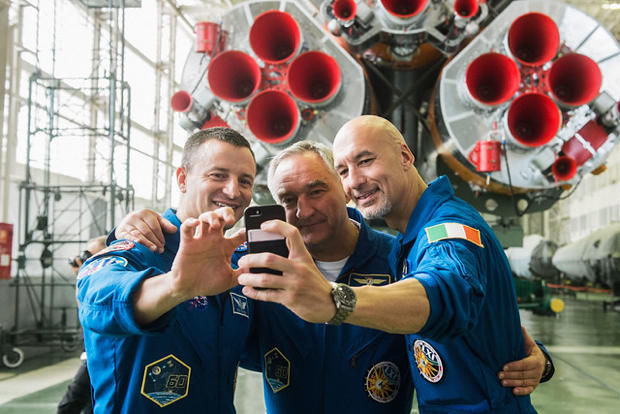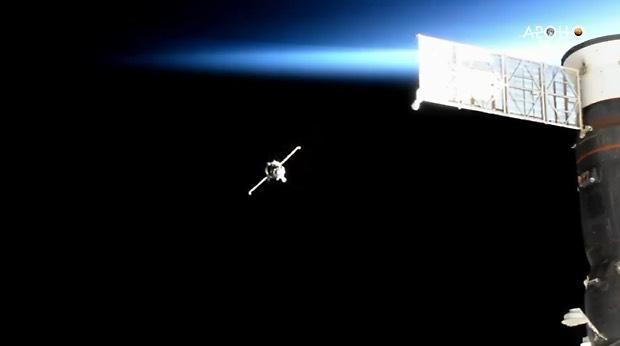Fifty years to the day after Neil Armstrong stepped onto the surface of the moon, a NASA astronaut, an Italian flight engineer and a Russian commander blasted off from Kazakhstan aboard a Soyuz spacecraft Saturday, chased down the International Space Station and glided in for a picture-perfect docking to close out a “textbook” four-orbit rendezvous.
A few hours earlier, Vice President Mike Pence celebrated the Apollo 11 anniversary with Buzz Aldrin, the second man on the moon, Armstrong family members and scores of space industry executives and lawmakers, reaffirming the Trump administration’s commitment to sending astronauts back the the moon in 2024 as a prelude to eventual flights to Mars.
At the White House Friday, President Trump appeared to question the need for a return to the moon, asking Aldrin and Apollo 11 crewmate Mike Collins what they thought of a direct-to-Mars approach. But in an interview with CBS News at the Florida spaceport Saturday, Pence said the moon remains the priority.
Trending News
“That’s 100 percent correct,” Pence said. “We understand when we go to Mars — and Americans are going to Mars — that we’re going to have to develop new technologies, new equipment and gain new experience that we can only gain on the moon. The president fully endorses that. … And I couldn’t be more excited to be part of it.”
Half a world away at the Baikonur Cosmodrome in Kazakhstan, NASA’s former Cold War rivals were focused on getting three fresh crew members to the International Space Station.
Soyuz MS-13/59S commander Alexander Skvortsov, Italian co-pilot Luca Parmitano and NASA physician-astronaut Andrew Morgan blasted off from Yuri Gagarin’s launch pad at the sprawling Kazakh space center at 12:28 p.m. EDT (9:28 p.m. local time), the first step in a four-orbit rendezvous with the laboratory complex.
The timing of the launch was coincidental with the Apollo 11 moon landing on July 20, 1969. But Morgan said the crew was honored to serve as a symbolic link between the past, when the United States and the former Soviet Union were engaged in a Cold War space race, and today, when international cooperation is the rule and not the exception.
“I can’t think of a better way to commemorate the 50th anniversary of the Apollo moon landing than launching on the anniversary with an international crew, especially in light of NASA’s reaffirmation that we intend to land a crew on the surface of the moon in 2024,” Morgan said before launch.
Armstrong and Aldrin, leaving Collins behind in lunar orbit, landed on the moon at 4:18 p.m. EDT on July 20, 1969. That 50-year milestone occurred as the Soyuz MS-13/59S crew was closing in on the International Space Station after a smooth climb to orbit.
Skvortsov, Parmitano and Morgan carried out a series of carefully scripted rocket firings to catch up with the lab complex, moving in for a docking at the aft end of the Russian Zvezda module at 6:48 p.m. Hatches were expected to be opened later, after lengthy checks to verify an airtight structural seal between the two spacecraft.
“I wanted to congratulate you on the beautiful, spectacular launch and your short trip to the ISS,” Kirk Shireman, NASA’s space station program manager, radioed from Baikonur. “Welcome to your new home.”
“Thank you, Mr. Shireman,” Morgan replied. “The crew feels great, and I feel great. I’ve got my first views out the windows of the ISS, and it’s as beautiful as I imagined. Thanks for everyone’s support.”
Standing by to welcome their new crewmates aboard were Expedition 60 commander Alexey Ovchinin and NASA flight engineers Nick Hague and Christina Koch. They were launched to the station on March 14 aboard the Soyuz MS-12/58S spacecraft and have been alone aboard the lab since June 24 when three other crew members returned to Earth.
Their replacements bring a wealth of experience to the station. Skvortsov is a veteran of two previous stays aboard the lab while Parmitano completed a long duration flight in 2013, coping with a harrowing spacewalk emergency. Morgan, an Army colonel making his first space flight, is an accomplished physician with extensive special operations experience.
After a short video chat with friends and family back at Baikonur, along with a mandatory safety briefing, Skvortsov and company will settle in and perhaps mark the moment, at 10:56 p.m. on Saturday, when Armstrong stepped onto the Sea of Tranquillity 50 years ago.
“The moon mission and the moon landing, the first steps of a human being on the surface of the moon, are so important,” Skvortsov said before the launch. “They are in the memory and in the hearts of every person on Earth. Such significant events demonstrate how important it is to go forward. I hope we keep going forward.”
The expanded six-member station crew faces an extremely busy summer and fall in space, with multiple spacewalks, the arrival and departure of multiple visiting vehicles and a full slate of scientific research.
After the arrival of a SpaceX Dragon cargo ship late next week and a Russian Progress freighter on July 31, the crew will welcome an unpiloted Soyuz on Aug. 24. The MS-14/60S spacecraft is being launched atop an upgraded Soyuz 2.1a booster on a test flight intended to clear the rocket for piloted launches next year.
One month later, on Sept. 25, yet another Soyuz will be launched, this one carrying MS-15/61S commander Oleg Skripochka, NASA Flight engineer Jessica Meir and United Arab Emirates guest cosmonaut Hazzaa Ali Almansoori. He will be the first non-professional flier, or “spaceflight participant,” to visit the station since Cirque du Soleil co-founder Guy Laliberté completed the 10th such stay in 2009.
NASA is preparing for commercial visitors of its own under a program to encourage private-sector utilization of the spacelab. A placeholder for the first potential “private astronaut mission” shows up on NASA’s international space station traffic chart in October 2020 with a second PAM flight in March 2021.
But those missions will depend on the successful testing and operational use of commercial crew ships being built by Boeing and SpaceX and it’s too soon to say when the launch of a U.S. private astronaut mission might actually occur.




